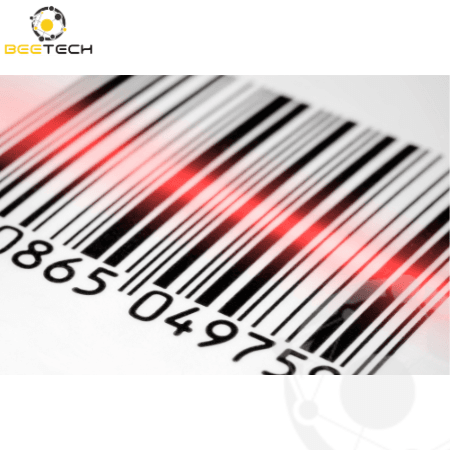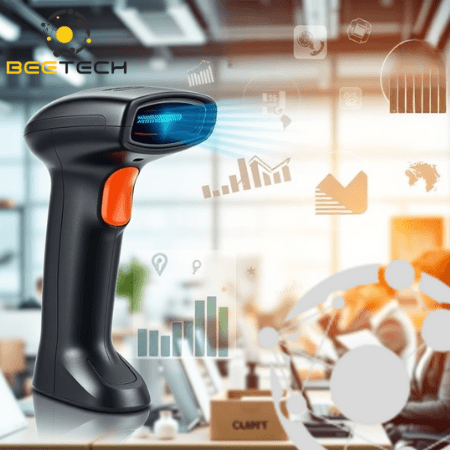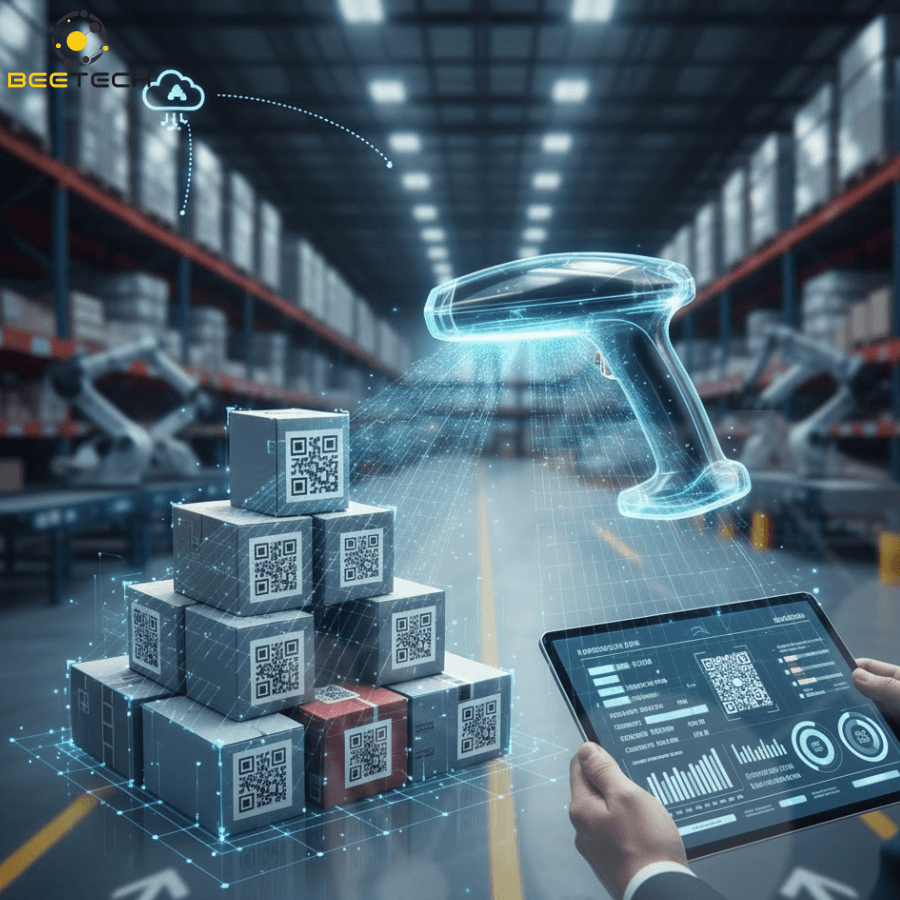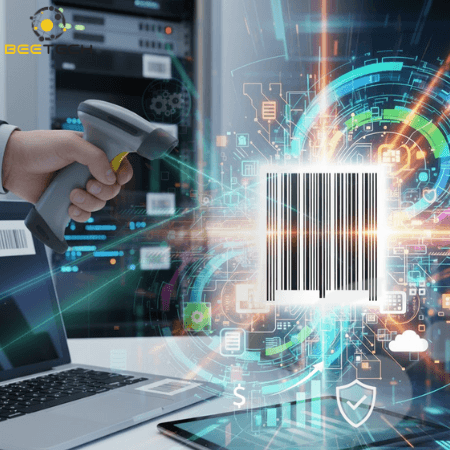80-82 Cao Duc Lan, District 2, HCMC, Vietnam
+84 76 865 6688
info@beetech.com.vn
+84 76 865 6688
About us
Contact us
80-82 Cao Duc Lan, District 2, HCMC, Vietnam
+84 76 865 6688
info@beetech.com.vn
+84 76 865 6688
About us
Contact us

GS1 US adopts 2D barcodes and intelligent data capture – Advancing toward a transparent and modern supply chain
In a world rapidly evolving toward digitalization and automation, the supply chain has become the lifeblood of every industry from manufacturing and retail to healthcare and logistics. Yet, many organizations continue to struggle with outdated systems, inconsistent labeling, and limited data visibility.
In response, GS1 US, the global standards organization for barcoding, has introduced a transformative concept: Intelligent Data Capture (IDC) a smarter, standards-based approach to collecting and managing data through GS1 standards and 2D barcodes.
According to the latest VDC Research report titled “Advancing Logistics Operations Through Intelligent Data Capture,” GS1 US emphasizes that standardized automation is the key to improving speed, efficiency, and transparency across the supply chain.

Despite years of technological investment, logistics operations still suffer from significant inefficiencies. The GS1 US and VDC Research study highlights that:
70% of logistics operations experience barcode readability issues every week mainly due to poor label quality, inconsistent labeling practices, or outdated scanning devices.
47% of companies have invested in 2D barcodes to enable faster data exchange and richer information sharing across supply chain partners. However, more than half have yet to upgrade, creating a widening technology gap.
43% are seeking greater traceability and transparency, especially in sensitive sectors like food and pharmaceuticals.
36% aim to improve asset tracking and warehouse management.
These figures clearly show that a “smart” supply chain cannot rely on fragmented data. Only when data is captured, shared, and synchronized under a common standard—such as GS1 Standards can organizations achieve operational agility and long-term resilience.
Intelligent Data Capture (IDC) goes far beyond faster barcode scanning. It represents a complete transformation in how data is generated, transferred, and utilized throughout the supply chain.
2D barcodes such as QR Codes and GS1 DataMatrix are replacing traditional 1D barcodes because they can store hundreds of times more information, including product codes, batch numbers, manufacturing dates, expiry dates, supplier identifiers, and traceability data.
This means every stage from production to distribution and retail is digitally connected. All relevant data is captured, verified, and accessible in real time, improving visibility and control.
GS1 US emphasizes that automation built on global standards eliminates manual, error-prone steps, increasing data accuracy and operational efficiency across industries.
GS1 Standards are recognized and adopted in more than 100 countries, serving as a universal language for product identification and data exchange.
The GS1 system includes:
Global identifiers such as GTIN, GLN, and SSCC uniquely distinguishing each product, shipment, and location within the supply chain.
GS1 DataMatrix and GS1 QR Code, which store large volumes of data in compact spaces.
EPCIS (Electronic Product Code Information Services), a protocol that enables real-time information sharing between trading partners.
By adopting these standards, companies can coordinate seamlessly, reduce labeling errors, avoid mix-ups in shipping and receiving, and strengthen transparency for consumers.
Migrating to GS1-compliant 2D barcodes is not just a technological upgrade it’s a strategic transformation that improves the entire supply chain model. Early adopters have already seen measurable results:
Faster operations: Modern scanners can read thousands of products per hour, even with damaged or faded labels.
Reduced labeling and input errors: When data is encoded using GS1 standards, the risk of manual data entry errors approaches zero.
Improved traceability: Each product carries its own digital “fingerprint,” allowing quick batch tracing in case of recalls or quality checks.
Increased transparency and consumer trust: Customers can scan a product to access full information about its origin, certifications, and quality standards critical in food and healthcare sectors.
Optimized inventory control: Integration with ERP/WMS systems enables real-time stock monitoring and accurate forecasting.
Enhanced sustainability: Eliminating redundant labels and reducing paper waste lowers both costs and environmental impact.
According to Gena Morgan, Vice President of Global Standards at GS1 US:
“In today’s data-driven supply chain environment, outdated systems, fragmented labeling, and manual processes are no longer sustainable. To remain competitive, businesses must move toward automation and standardization built upon GS1 standards.”
She added that as companies face increasing pressure for traceability, rapid fulfillment, and waste reduction, industries from retail and food to healthcare and apparel can make significant progress by adopting GS1-compliant 2D barcodes.
Beyond logistics and retail, GS1 US plays a critical role in helping U.S. companies comply with the Drug Supply Chain Security Act (DSCSA).
Ullrich Mayeski, GS1 US Healthcare Community Engagement Director, explained that DSCSA implementation is not a one-company effort but an industry-wide collaboration:
“The good news is that the industry doesn’t have to reinvent the wheel. GS1, the HDA, and other organizations have already developed detailed implementation guides to help businesses comply. They’ve also established best practices for handling exceptions such as when product data doesn’t match shipments or when items arrive without the correct data.”
This collaborative approach ensures full end-to-end traceability, helping manufacturers, distributors, and pharmacies prevent disruptions while maintaining compliance.
Industry experts predict that within the next five years, smart logistics will become a cornerstone of business success. The integration of AI (Artificial Intelligence), IoT (Internet of Things), and GS1-based 2D barcodes will empower organizations to:
Monitor product conditions in real time (temperature, humidity, location).
Predict transport risks and supply chain disruptions.
Automate inventory and fulfillment processes with minimal human input.
Provide consumers with full transparency via a single scan.
The ultimate goal is a fully connected, intelligent, and transparent supply chain—a vision GS1 US continues to drive globally.
In an era where speed, data, and transparency define competitiveness, companies that delay digital transformation risk falling behind. Implementing 2D barcodes and GS1 standards not only enhances internal efficiency but also builds long-term trust, transparency, and sustainability.
GS1 US is leading this global shift, empowering businesses to thrive in a post-automation era where data is not just information but the driving force of global operations.
In Vietnam, Beetech proudly stands as a pioneer in helping businesses embrace this digital transformation journey.
With deep expertise in barcode, RFID, and automatic identification solutions, Beetech supports organizations in shifting from manual management to intelligent, data-driven operations enhancing visibility, efficiency, and traceability across the entire supply chain.
Beetech – Empowering smart supply chains through barcode & RFID technology.
📧 Email: info@beetech.com.vn
🌐 Website: https://beetech.com.vn

See more products: Here


Barcode Technology in the Digital Age: Types, Advantages, Limitations, and How Businesses Can Choose the Right One
18/11/2025 04:12:49

5 Barcode Secrets That Smart Businesses in Vietnam Are Using to Boost Logistics Efficiency
12/11/2025 08:00:46

GS1 US adopts 2D barcodes and intelligent data capture – Advancing toward a transparent and modern supply chain
07/11/2025 06:33:27

Barcode Technology: The Classic Tool Evolving for a Digital Supply Chain Era
06/11/2025 03:37:29

Barcode – An efficient and cost-effective asset management solution for modern businesses
05/11/2025 04:20:46

The future of barcode scanning technology: Key trends and practical applications in the digital era
31/10/2025 04:21:05